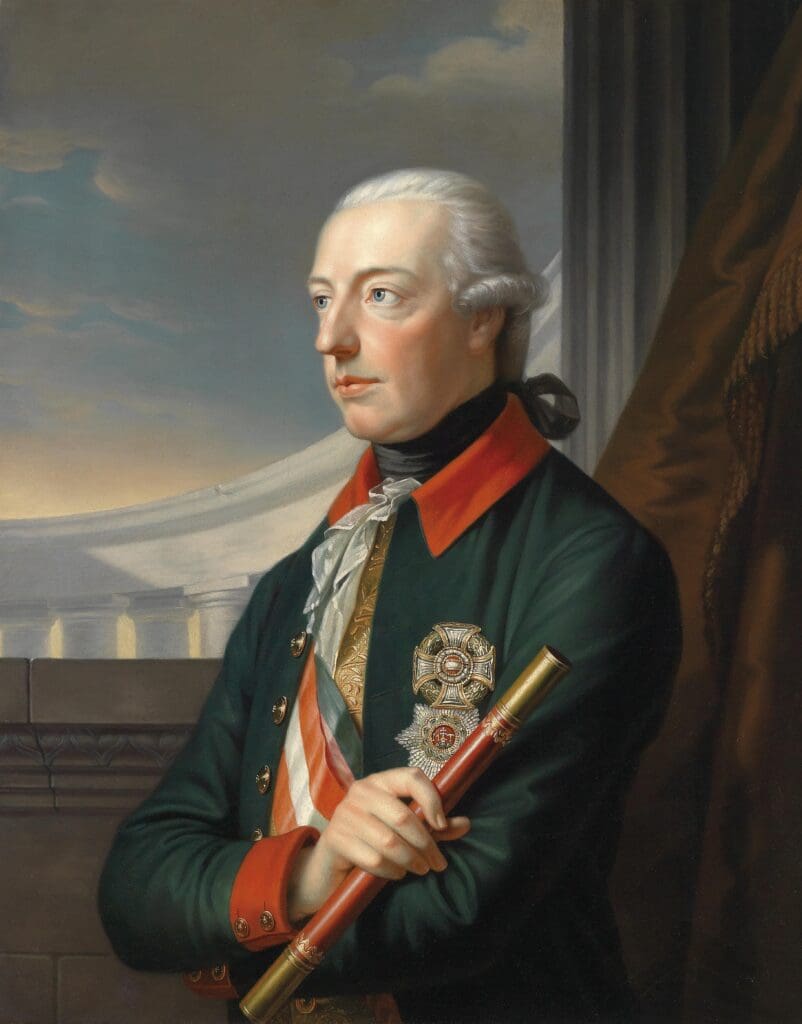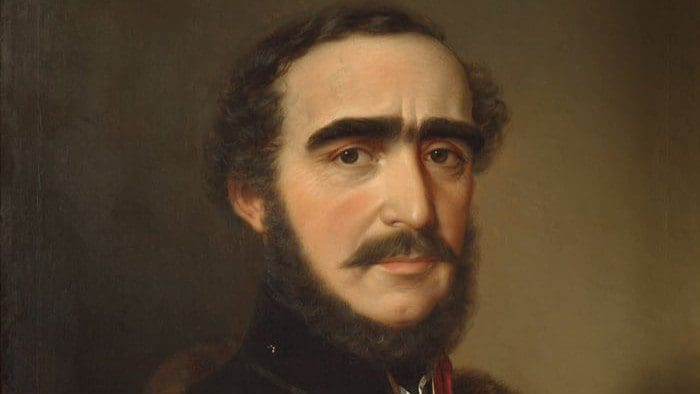The kuruc–labanc dichotomy was transformed into a Hungarian version of ‘court and country party’ during the early modern age. This framework dominated Hungarian politics during most of the age, as well as in the nineteenth century.
Enlightened Absolutism and the Josephinists
An interesting interlude to the kuruc-labanc debate occurred during the late eighteenth century. Joseph II (1780–1790), the enlightened absolutist emperor of Austria, decided to sideline the estates in his quest to impose reforms on Hungary. On the one hand, he tried to ease the burden of the serfs, encourage their education, as well as enact laws more tolerant toward Protestants, in a general attempt to uplift the more marginalised groups of society. On the other hand, he tried to do so with the complete disregard toward the constitution of Hungary. He never consulted the Diet, and instead resorted to decrees, in order to evade opposition from the estates.
Joseph II’s policies led to widespread resistance in Hungary. Many social classes, and almost all the nobility were against his radical reforms. However, a small group of progressive aristocrats and intellectuals did in fact support the emperor. Hence their name: ‘josephinists’. Members of the group wrote elaborate reform plans and wanted to transform Hungary entirely. Their leader was Gergely Berzeviczy, but their ranks also included the most famous reformer of the Hungarian language, József Kazinczy. The josephinists were unique in combining radical progressivism with—mostly unspoken—loyalty to the Habsburgs. Thus, most of them stood with Joseph II, even after he declared German the official language of Hungary, and disbanded the counties, the seats of the estate’s corporative autonomy. The josephinists took a leading role in the new, centralised administration, eagerly supporting the enlightened part of Joseph II’s agenda,
such as religious tolerance, and equality before the law,
while turning a blind eye to the Germanizing aspirations. This new order fell apart in 1790, when the emperor died, and on his deathbed annulled most of his decrees.

The evaluation of the josephinists is dual in Hungary. According to the liberal-progressive assessment, they are seen as positive figures, who wanted to lead Hungary out of feudalism, and into a more modern political, economic, and social system. On the other hand, in conservative circuits the term josephinist is often used as a slur against those who put their progressive ideals before national interest and independence.
The Era of Cooperation
The successor of Joseph, Leopold II (1790—92) struck an agreement with the estates. After tacitly supporting movements of disgruntled peasants to scare the mobility, and in exchange of continued dynastic loyalty, he restored feudal privileges and the corporative system. Act X of 1790–91 declared that Hungary is ‘free…and independent, thus is not a dependency of any realm or province’ and was to be governed according to its own laws and customs. Another law bolstered the use of the Hungarian language.
The josephinite interlude briefly united kuruc and labanc nobles.
With the exception of the slim minority of the josephinists, the entire nobility opposed the absolutist aspirations of Joseph II. The opposition to the emperor strengthened the kuruc tradition across the political spectrum, making its ideas and thinking more mainstream. Even the more loyal aristocracy opposed the enlightened absolutist tendencies, so the estates created a united front against them. During the late 1880s, more than half of the counties demanded that the king (who was derogatorily referred to in Hungary as the hatted king, since he was never actually crowned with St Stephen’s crown) convoke the Diet, which happened immediately after Leopold stepped onto the throne.
The leader of the united estates was Péter Balogh, who wrote the first resolution of the Diet, according to the ideas of Rousseau, demanding respect for the social contract. Of course, what he meant was a contract between the king and the estates. The reformist faction of the Diet, prominently represented by intellectuals of noble origin, like Gergely Berzeviczy, saw the British constitutional monarchy as their role model. These reformers sought to restrict the power of the king, as well as to strengthen the role of the nobility and the Diet. An important goal of this movement was to reform the corporative system and expand Hungary’s autonomy within the Habsburg Empire.
However, soon a more radical movement of non-noble intellectuals, led by József Hajnóczy and Károly Kopi, also appeared. These former josephinists demanded equality before the law, the abolition of privileges, as well as taxation of the nobility. However, these radicals remained marginal all along.
All in all it can be said that in these years, the kuruc–labanc dichotomy was less pronounced, as the nobility and the intelligentsia was united in their demand for reform and autonomy. Debates only occurred regarding their extent and pace. Eventually, the moderate reformists were able to transform many of their ideas into legislation, striking the above-mentioned deal with the king. What the intellectual discourse of the era did, however, was invigorate political life, eventually leading to what is now called the Reform Era (or Era of Reform).
Prelude
The prelude of the Reform Era can be detected in the so called ‘continuous committee operations’. The Diet elected deputies to eight Diet Committees (‘regnicolaris deputatio’), which were tasked with submitting proposals to the Diet in their respective fields of expertise. This once again united the moderate and radical reformists, as representatives of both camps participated in this enormous work. The enlightened nobles sought to reform all areas of politics, economy, and society, even at the expense of the estates and the court. Among other things, the restructuring of the Habsburg tariff and industrial policy, the bolstering of public education, as well as a reform of the law enforcement and penal policies were proposed. However, these ideas reform ideas were not supported by the Court under the conservative Francis I and were shelved until the 1820s.
The Protagonists of the Reform Era
The most widely accepted starting date for the Reform Era is 1825, the opening of the session of the so- called first ‘Reform Diet’ (1825–27). During this session, the estates discussed the results of the Committees, and drew up many progressive draft laws, including legislation aiming to ease the conditions of the serfs, strengthen press freedom, modernise the courts, and bolster industry. Most of these, however, were vetoed by the King during both this and next, 1832–36 Diet session.
Another important milestone is 1830, when István Széchenyi, ‘the greatest Hungarian’, as he is called, published his work Hitel (Credit). In this book he called for capitalist modernisation, and the transformation of Hungary into a British-style constitutional monarchy. Széchenyi, while normally not considered a labanc, explicitly opposed the traditional gravaminalist policy of provoking confrontations with the Court. He genuinely believed that the Habsburgs, and especially Metternich, could be won over for the cause of the reforms. He wanted to institute top-down social and economic reforms (e.g. equality before the law, taxing the nobility, abolishing the guild system, liberalising the selling of land and taking out loans, etc.) in cooperation with the King.
Széchenyi came from an ‘aulicus’, therefore technically labanc, loyalist background, which determined his conviction that
it was necessary to cooperate with the Court in order to achieve reforms.
He had two prominent opponents and partners in constructive debates, one of them being Lajos Kossuth, and the other Miklós Wesselényi. Wesselényi, a close friend of Széchenyi, was a Transylvanian aristocrat, who, as he outlined in his book Balítéletekről (which translates as Of Prejudices), believed in a different approach. He thought that the way forward was to revitalise the county assemblies, the traditional forums of the gravaminalist estates. He wanted to achieve this by democratising these forums, expanding suffrage to more people, while bolstering the emancipation of the serfs. As opposed to the cautious reformist approach and economic focus of Széchenyi, his main goal was to achieve more autonomy for Hungary and weaken the absolutism of the Habsburgs. Wesselényi was one of the leading figures of the 1832–36 Diet, where he tried to put focus on the political, rather than the economic issues, which led to clashes with the more moderate deputies.
Conclusion
To sum up, the kuruc-labanc conflict was frozen during most of the late eighteenth and early nineteenth century, surfacing only during and due to the Era of Reforms. The absolutism of Joseph II forced all factions of the estates into a unity front, while the reconciliatory policies of the court during the 1790s and the early 1800s mended the ties to the Habsburgs as well. However, during the Era of Reforms, the political questions forced the estates to take position on how to further the reforms: together or against the will of the court. This led to the resurfaced conflict.








